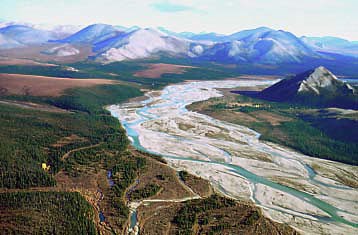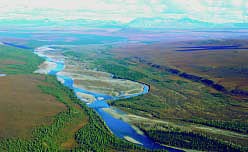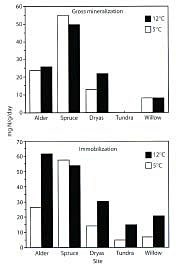Part of a series of articles titled The Legacy of ANILCA.
Article
Long–term Research in Remote Parks: Opportunities and Obstacles
By Robert Stottlemyer

Photograph courtesy of Bob Stottlemyer
Introduction
In establishing a number of new expansive parks and enlarging several existing NPS units in Alaska, the opportunity for remote site investigations and conducting important baseline research was enhanced. Remote wilderness areas provide unique opportunities and challenges for the conduct of interdisciplinary ecological studies. One advantage is the opportunity to document baseline conditions for future reference. If the remote area is large, the baseline may have to represent a region. Disadvantages include logistics and constraints on research, particularly experimental designs and the quality of monitoring necessary for a research context.National parks are not often used for long-term interdisciplinary research. There can be good reasons for this. Data gathering in the more intensively used and developed parks is often prioritized to address specific resource management issues. Objectively designed long-term studies are rarely suited to address immediate issues. However, in developing policies and in order to support them, it became evident that long-term, ecosystem level, interdisciplinary studies were needed. Below are examples of these types of studies that are carried out in remote wilderness areas.
Conceptual Ecosystem Model
Since the 1930s, scientists recognized that ecosystems have detailed energy and nutrient input and output budgets, with nutrient supply as the factor most limiting biological growth. But a lack of under standing of internal processes regulating nutrient and energy transformations and movements in ecosystems made it difficult to separate and quantify the effects of regulatory processes such as human activity.To gain insight into such complex systems, a new conceptual approach was needed, one that considered ecological systems as interacting units rather than a set of individual components. By the 1950s, an ecosystem model was developed where major parameters could be measured directly in the field (Bormann and Likens 1967, Likens 1983). By linking hydrology with other ecosystem processes, the “small watershed ecosystem” model permitted quantification of biogeochemical cycles, i.e., the movement and transformation of nutrients and energy between the biotic and abiotic components.

Photograph courtesy of Bob Stottlemyer
Application of Model in Boreal Ecosystems
In 1980 we began long-term studies using this conceptual model in a network of national parks. One site, the boreal Wallace Lake watershed, is in Isle Royale National Park, Lake Superior Basin, Michigan (Stottlemyer et al.1998). About 99%of the park is wilderness, and it is one of the least visited national parks, accessible only by boat or float plane. Isle Royale is located along the southern ecotone (the boundary or transition area between two or more ecosystems or landscapes) between the boreal and northern hardwood forests. Globally, the boreal biome covers 32% of forested areas, second only in extent to tropical forests (Mayer et al. 2005). About 20% of national park lands are in the boreal biome; however, the biome is little studied relative to its global importance.In 1989, we began similar monitoring and research in Noatak National Preserve, Alaska. Noatak is one of the few national park units with research specified as a priority in its enabling legislation (ANILCA).
The preserve provided the opportunity to study the northern boreal treeline ecotone and compare it to the ecotone found at Isle Royale. Ecotones, with many of their species at the limits of their range, are especially sensitive to stressors.
At our sites research emphasizes below-ground, physiochemical and biological processes, and microbial functional biodiversity. Greater than 99% of ecosystem biodiversity usually is in the subsurface layers. Half of the total terrestrial system production can occur below-ground, primarily in the form of microbial (bacteria, fungi) and small root growth. Therefore, the below-ground comunity regulates the quality and quantity of most nutrients and almost half the energy available to above-ground biota.
One of our Noatak intensive study sites, the 1,980 acre Asik watershed, is located in the southcentral portion of the preserve. The Asik watershed drains into the Agashashok River, and 50% of the treeline watershed is vegetated by white spruce.
Another site is located along the Kugururok River just north of its confluence with the Noatak River, at the northern extent of treeline. The region is characterized as “cold desert” with annual precipitation less than one foot and with discontinuous permafrost.

Study in Remote Area Sites
Science benefits in unique ways from work in regions where the human “imprint” remains less evident. Remote sites can provide another interdisciplinary “data point” in regions where such information often has disproportionately high value because of its scarcity. The study design and factors, such as quality assurance, are particularly important in this context.A number of examples exist demonstrating the value of remote boreal sites, especially in national parks with the restricted land use, where they provide benchmark interdisciplinary studies. One such example is the continuous (1951-present) long-term, predator-prey studies on Isle Royale (Allen 1979, Post et al. 1999). This research has provided much needed resolution and evolution in predator-prey conceptual models. Such studies cannot be repeated because of the loss of suitable sites, and new ones cannot recreate the detailed changes that have already occurred.
For the level of effort, simple monitoring in remote regions for limiting nutrients like nitrogen can be quite productive. In the contiguous 48 states, one hypothesis suggests in regions of anthropogenic-elevated atmospheric dissolved inorganic nitrogen (DIN) deposition, stream water nitrogen concentrations should be dominated by atmospheric DIN inputs. The stream water should not be dominated by other nitrogen forms, such as dissolved organic nitrogen (DON), which are more indicative of terrestrial processes. In Alaska, atmospheric DIN deposition is low (<0.3 kg Nper hectare per year), or about 5% of the deposition on Isle Royale, yet stream water nitrogen is dominated by DIN. This has led investigators to look for the causes for why treeline and taiga ecosystems are losing this nutrient when atmospheric inputs are so low.
Remote parks can be valuable in quantifying the historical sources of substances, such as polychlorinated compounds, which are only associated with human activity. When such compounds are found cycling in the ecosystem where they were never used, it simplifies the task of finding the source. The results for the remote sites generally indicate ambient conditions representative of the larger region. A complex study of the inputs and cycling of polychlorinated compounds in Siskiwit Lake at Isle Royale National Park documented past and present cycling of dioxins and furans at a site where atmospheric inputs could be the only source (Czuczwa et al. 1984). Such studies were the impetus for the present widespread monitoring for such com-pounds in the Arctic and Antarctic.
High latitude sites are, in general, simpler ecologically. An important component of the Noatak landscape is the diverse vegetation along river terraces. In a study conducted on a river terrace adjacent to the Asik watershed, the depth of silt and sand cap above a gravel floodplain greatly influenced species composition, production, and response to change (Binkley et al. 1995).
Likely one of the most valuable contributions to science by protected, remote sites will be documenting global change effects, principally climate (Figure 6). In Alaska these studies are being driven by the rapid rate of change in temperature and moisture in taiga-tundra regions. The rapid change rates may also be a weakness in the study of ecosystem processes responsive to temperature and moisture, since there is no baseline for the last five decades.
The boreal biome contains large but mostly unavailable subsurface reservoirs of organic carbon, nitrogen, and phosphorus. High latitude ecosystems contain about a third of the global soil carbon pool as organic matter (Shaver et al. 1992). In the Noatak treeline, most of the organic matter is below the annual thaw depth (soil active layer) and unavailable to biota. Any factor that increases the depth of the soil active layer would also alter soil temperature and moisture, organic decomposition, soil respiration rates, and nutrient availability. The alteration of nutrient availability is through increased mineralization rates. Such change would realign below-ground and eventually above-ground biodiversity.
Another apparent effect of a warming climate in the Noatak area is the expansion of the growing season into autumn. At Asik, air temperatures peak in June, but soil temperatures now peak in late August or early September. This permits soil carbon and nitrogen mineralization processes to continue late in the season, after biological uptake has slowed. This process likely accounts for the high dissolved organic carbon and nitrate found in late summer stream water. Along with phosphorus, these substances are important aquatic nutrient and energy sources especially for the base of the aquatic food web. This increase in available nutrients and energy sources will likely alter aquatic food web biodiversity.
In sum, longer-term studies in remote parks likely provide the best remaining opportunities to catalog baseline ecological structure and function. Documenting base-line conditions assumes still greater importance now that there is increased appreciation of the significant economic value ecosystem services provide. Yet such study remains difficult to justify and sustain because it falls victim to immediate issues, many of which were brought about by the lack of a basic understanding of ecosystem function through time. And the latter, more often than not, is the product of little commitment to anticipatory science. The Park Service is left with a unique opportunity and major obstacle. The opportunity is to actively support and become substantively involved in sustained study. The obstacle is to overcome a myopic view of the information base necessary to professionally care for its public lands.
References
Allen, D. L. 1979
Wolves of Minong: their vital role in a wild community. Houghton Mifflin Co. Boston.
Binkley, D., R. Stottlemyer, F. Suarez, and J. Cortina. 1994.
Soil nitrogen availability in some arctic ecosystems in northwest Alaska: responses to temperature and moisture.
Ecoscience 1(1):64-70.
Binkley, D., F. Suarez, C. Rhoades, R. Stottlemyer, and D.W. Valentine. 1995.
Parent material depth controls ecosystem composition and function on a riverside terrace in northwestern Alaska.
Ecoscience 2(4):377-381.
Bormann, F.H., and G.E. Likens. 1967.
Nutrient cycling. Science 155:424-429.
Czuczwa, J.M., B.D. McVeety, and R.A. Hites. 1984.
Polychlorinated dibenzo-p-dioxins and dibenzofurans in sediments from Siskiwit Lake, Isle Royale.
Science 226:568-570.
Likens, G.E. 1983.
A priority for ecological research.
Bulletin of the Ecological Society of America 64(4):234-243.
Mayer, A.L., P.E. Kauppi, P.K. Angelstam, Yu Zhang, and P.M. Tikka. 2005.
Importing timber, exporting ecological impact. Science 308:359-360.
Post, E., R.O. Peterson, N.C. Stenseth, and B.E. McLaren. 1999.
Ecosystem consequences of wolf behavioral response to climate. Nature 401:905-907.
Shaver, G.R., W.D. Billings, F.S. Chapin III, A.E. Giblin, K.J. Nadelhoffer, W.C. Oechel, and E.B. Rastetter. 1992.
Global change and the carbon balance of arctic ecosystems. BioScience 42(6):433-441.
Stottlemyer, R., D. Toczydlowski, and R. Herrmann. 1998.
Biogeochemistry of a mature boreal ecosystem: Isle Royale National Park, Michigan.
Scientific Monograph NPS/NRUSGS/NRSM-98/01. National Park Service. Washington, D.C.
Allen, D. L. 1979
Wolves of Minong: their vital role in a wild community. Houghton Mifflin Co. Boston.
Binkley, D., R. Stottlemyer, F. Suarez, and J. Cortina. 1994.
Soil nitrogen availability in some arctic ecosystems in northwest Alaska: responses to temperature and moisture.
Ecoscience 1(1):64-70.
Binkley, D., F. Suarez, C. Rhoades, R. Stottlemyer, and D.W. Valentine. 1995.
Parent material depth controls ecosystem composition and function on a riverside terrace in northwestern Alaska.
Ecoscience 2(4):377-381.
Bormann, F.H., and G.E. Likens. 1967.
Nutrient cycling. Science 155:424-429.
Czuczwa, J.M., B.D. McVeety, and R.A. Hites. 1984.
Polychlorinated dibenzo-p-dioxins and dibenzofurans in sediments from Siskiwit Lake, Isle Royale.
Science 226:568-570.
Likens, G.E. 1983.
A priority for ecological research.
Bulletin of the Ecological Society of America 64(4):234-243.
Mayer, A.L., P.E. Kauppi, P.K. Angelstam, Yu Zhang, and P.M. Tikka. 2005.
Importing timber, exporting ecological impact. Science 308:359-360.
Post, E., R.O. Peterson, N.C. Stenseth, and B.E. McLaren. 1999.
Ecosystem consequences of wolf behavioral response to climate. Nature 401:905-907.
Shaver, G.R., W.D. Billings, F.S. Chapin III, A.E. Giblin, K.J. Nadelhoffer, W.C. Oechel, and E.B. Rastetter. 1992.
Global change and the carbon balance of arctic ecosystems. BioScience 42(6):433-441.
Stottlemyer, R., D. Toczydlowski, and R. Herrmann. 1998.
Biogeochemistry of a mature boreal ecosystem: Isle Royale National Park, Michigan.
Scientific Monograph NPS/NRUSGS/NRSM-98/01. National Park Service. Washington, D.C.
Last updated: October 23, 2021
